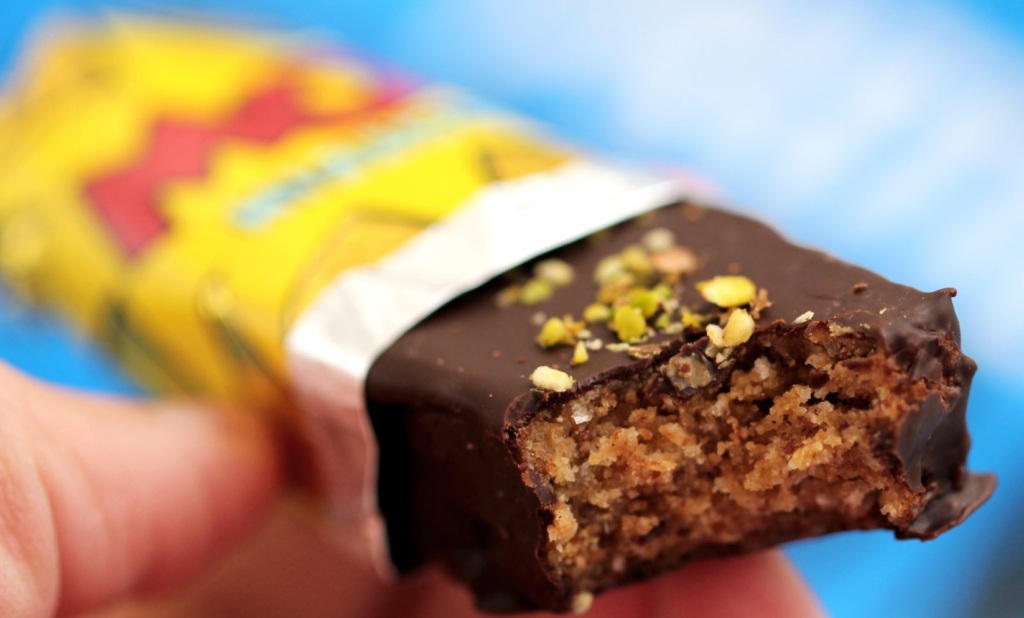
Protein bars are an effective way to hit your daily protein goals or as a lifestyle choice to eat healthier.
Many people carry them everywhere for snacking and for a better alternative to eating bad carbs or junk food. They’re also great for breakfast, post workout, or for out on the trails.
Whether you are looking to put on muscle, lose weight with a meal replacement, or just need a snack to stash in your car, there’s a protein bar out there for you. We ranked the best protein bars on the market all in one place.
1. NuGo Slim
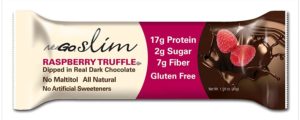
Click here for the lowest price on Amazon
Here’s a new idea: a protein bar that’s low in carbs but doesn’t dump in a bunch of sugar to make up for it. That’s what NuGo is.
Instead of artificial sweeteners, it uses chicory root and just a touch of chocolate to flavor its bars. The result is 17 grams of protein, 2 grams of sugar, and 7 grams of fiber: pretty impressive stats for something with no sugar alcohols.
2. Optimum Nutrition Opti-Bar

Click here for the lowest price on Amazon
Targeted at bodybuilders, this protein bar strives to provide a lot of protein but stay lean when it comes to carbs. It delivers an impressive 20 grams of protein and 10 grams of fiber, but only one gram of sugar.
Though there aren’t sugar alcohols, the second ingredient is isomalto-oligosaccharide, another non-caloric sweetener. Your call on whether that’s an issue.
3. RXBar

Click here for the lowest price on Amazon
They say “don’t reinvent the wheel” but that’s more or less what RXBar did: they rebuilt the very idea of a protein bar from the ground up.
Want simple? How about six ingredients? Dates, egg whites, almonds, cashews, chocolate, and sea salt. Put those together and you get tons of fiber, 12 grams of protein, and a moderate 15 grams of sugar (none of it added).
4. Epic All-Natural Meat Bar

Click here for the lowest price on Amazon
The whole reason protein bars were invented was because it isn’t very convenient to carry around high-protein meals when you are on the go.
Apparently, until Epic came along, nobody realized you could just preserve some lean meat, season it with spices, and pack in some chia seeds good measure. Fifteen grams of fiber and zero sugar–can you complain? Well, yes, if you want fiber: there isn’t any of that in an Epic Bar, either.
5. OhYeah! Nutrition ONE
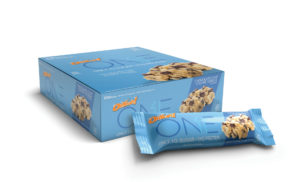
Click here for the lowest price on Amazon
They call it the ONE bar because there’s only one gram of sugar per bar. With that, 21 grams of protein, and 9 grams of fiber, the stats are pretty impressive.
The ONE bar is heavy on saturated fat, so if that’s an issue for you, take note. It also uses 10 grams of sugar alcohols to improve the taste. Again, depending on what you are looking for in your protein bar, that may or may not be a problem.
6. Pure Protein Bar
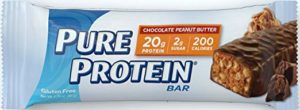
Click here for the lowest price on Amazon
Want tons of protein and almost no sugar? One option is a Pure Protein Bar. 21 grams of protein and only 3 grams of sugar! How do they do it? Artificial sweeteners. All the sweetness is provided by a sugar alcohol, so if that’s not your thing, steer clear of this one.
7. thinkThin High Protein Bars

Click here for the lowest price on Amazon
Marketed directly as a meal replacement bar, thinkThin has that too good to be true feel to it: 20 grams of protein and zero sugar? The catch is…there is a ton of sugar alcohols in it. Twenty-one grams, to be exact! No fiber either, so though it’s got a lot of protein, it’s not going to fill you up like a meal replacement bar should.
8. Larabar
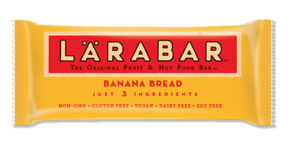
Click here for the lowest price on Amazon
Larabar takes the all-natural approach: they use dates and real fruit to build their bars, and no artificial ingredients. The result is a bar that’s good for you, but is carb-heavy (though none of the 16-19 grams of sugar, depending on the flavor, are added sugar) and pretty low in protein: only four to six grams.
9. KIND Bars
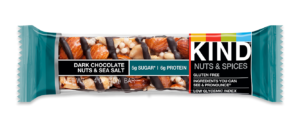
Click here for the lowest price on Amazon
KIND bars are nutty, fairly low in sugar at 9 grams, but only pack in seven grams of protein. They rank well when it comes to health, but as far as actually getting protein in, they’re a bit lacking. Despite the “natural” approach, KIND bars are pretty short on fiber, too, at only 2.5 grams.
10. Clif Builder’s Bar
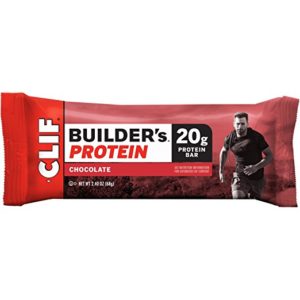
Click here for the lowest price on Amazon
Clif Bar has been king of protein bars for a long time, but with the rising crusade against added sugar, the sweetener-laid traditional Clif bar didn’t even make our list.
Even the Builder’s Bar, with an impressive 20 grams of protein, finds itself pretty low with its eye-popping 22 grams of sugar. This one has plenty of protein, but all that sugar and a meager 2 grams of fiber is not good for your overall health.
Protein bars benefits and side effects
You need protein to put on muscle mass, and strangely, you also need it if you want to lose fat. It’d be great if you always had fresh-cooked lean protein meals ready to go, but most of us don’t.
That’s where protein bars come in. Pioneered by sports-focused companies like PowerBar and Clif Bar, the category has a giant market size today.
Protein bars are useful primarily for three things: gaining muscle, losing weight as a meal replacement, and as a versatile, all-around snack when you are on the go.
The ingredients of a protein bar dictate, more or less, to what extent it’s useful for each of these categories.
Benefits
The main benefit of a protein bar (a good one, at least) is, obviously, the protein content. What does protein do for you? It’s no secret it helps you build muscle.
That’s been so universally accepted as doctrine now that it hardly needs proof. But in case you had any doubt, plenty of science has demonstrated that supplementing with protein works definitively. Here’s something you might not know–it works for everyone, not just young, fit-looking lifters.
A 2012 study published by scientific researchers in The Netherlands demonstrated that protein supplementation helps frail elderly people add muscle during a weightlifting program (1).
This study used a twice-daily supplement of 15 grams of protein, which is right in the ballpark of what you’d find in a decent protein bar. So, if adding muscle mass with protein works for 80-year-old elderly people, it’s definitely going to work for you.
If you want to add muscle mass, your number one priority is its protein content. So check that nutrition label and get a bar that packs in as much protein as possible.
For weight loss, it’s a little different. Oddly, you still want a good amount of protein. This was demonstrated in a 2008 study in the journal Nutrition and Metabolism (2).
In the study, one group of subjects was given a protein supplement drink to take daily, while the other group was given a similar carbohydrate-only drink.
During the course of the study, the subjects who took the protein supplement were able to lose more body fat while maintain their lean muscle mass. If you want to progress more quickly to your desired body shape, this is definitely the way to do it.
At first, it seems a little off: how could eating more protein help you lose weight? We know protein helps build muscle, so the muscle mass maintenance makes sense. But what about losing fat?
The best explanation has to do with satiety, or the feeling of fullness you get after a meal. It’s a well-known phenomenon that protein increases fullness to a much greater extent than an equal amount of calories from carbohydrates.
Some possible mechanisms for this were laid out in a 2008 scientific article by European researchers (3). The details of this aren’t important; the bottom line is that protein fills you up, so keep the protein content high.
The other part of the weight loss equation is fiber content. Dietary fiber is also known to increase satiety, and one repeated observation that obesity researchers have made is that people who eat more fiber tend to weigh significantly less.
As far back as 2000, nutrition researchers were outlining the function of dietary fiber in increasing fullness and fighting weight gain (4).
What’s this mean? If you want to use a protein bar as a meal replacement, look for something that combines high protein and high dietary fiber content.
Lastly, if you want to lose weight, you should also keep the sugar content low. From the looks of the epidemiological research, sugar is public enemy number one in the fight against obesity.
Multiple large-scale long-term studies have found an association between sugar intake and weight gain, as well as the negative health effects associated with it, like metabolic syndrome and type two diabetes.
An influential paper published in 2001 in the Lancet by Dr. David Ludwig and other researchers at Harvard University and Boston Children’s Hospital found that each additional serving of sugar-sweetened drink per day, body mass index increases by 0.24 kg/m2 –and remember, it only takes a few points of BMI to tip you from healthy to overweight, or from overweight to obese (5).
The American Heart Association recommends a maximum of 37 grams of added sugar per day for men, and only 25 per day for women (6).
Considering that some protein bars have over 20 grams of sugar per serving, it’s pretty hard to stay below this limit if you are eating a sugar-laden protein bar.
So, the upshot of all this is that, for optimal muscle-mass benefits, focus on protein. For weight loss, keep the protein and fiber high, and the sugar low.
For an all-around snack, the same weight loss constraints are pretty good ones: this will help you maintain your weight and metabolic health, as well as satiating your hunger.
Side effects
One of the nice things about protein bars is that they are, for the most part, just food. So they don’t really have any distinct side effects outside of their nutritional constituents.
Of course, eating too much of the wrong kind of protein bar isn’t going to be the best thing for your long-term health. Too much sugar, or not enough fiber, could have an impact on your metabolic health, so watch your proportions and watch your nutrition labels. This applies to everything else in your diet, too, not just protein bars.
One notable exception to this rule are protein bars with a lot of sugar alcohol in them. In high doses, these can cause stomach pain, bloating, and other gastrointestinal side effects.
A scientific article in the International Journal of Dentistry by Kauko K. Mäkinen describes in detail the uncomfortable side effects that some people experience when consuming sugar alcohols (7). If you know you get gastrointestinal troubles from artificial sweeteners, steer clear of protein bars that use them.
Recommended Use
How often you want to take a protein bar is going to be contingent on what you’re trying to accomplish. For muscle building purposes, you’ll want to calculate your goal for your additional daily protein intake, then divide it by the amount of protein in your protein bar of choice.
In any case, you probably don’t want to eat more than three a day; otherwise that probably means you are getting lazy with your actual meals.
As a meal replacement for weight loss, you are looking at one or maybe two a day, either replacing lunch or functioning as a late brunch and mid-afternoon snack (without any lunch in the middle).
Even while on a diet, you still want a real breakfast and dinner, since that’s the best way to get your fruits, vegetables, and fiber in your diet. Those are important for losing weight, too.
If you are just looking for a snack, the protein content is not quite so important, but don’t forget to keep the sugar content low and the fiber content high–otherwise you’re just eating a glorified candy bar.
As we saw in the research earlier, protein and fiber fill you up, making you feel more full. This is exactly why people use protein bars as a meal replacement.
Recap
When you are busy or on the road, it’s hard to beat a protein bar when it comes to a quick pick-me-up that fills you up and gets you the protein you need.
The ideal protein bar has lots of protein and fiber, and as little sugar as possible–while still tasting good. It’s that last part that often proves tricky once you’ve found the nutritional value that you want.
https://bodynutrition.org/protein-bars/
No comments:
Post a Comment